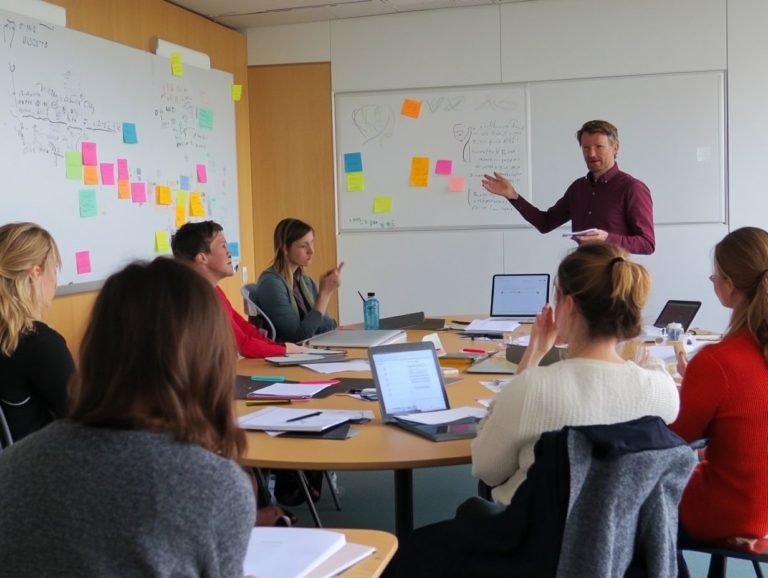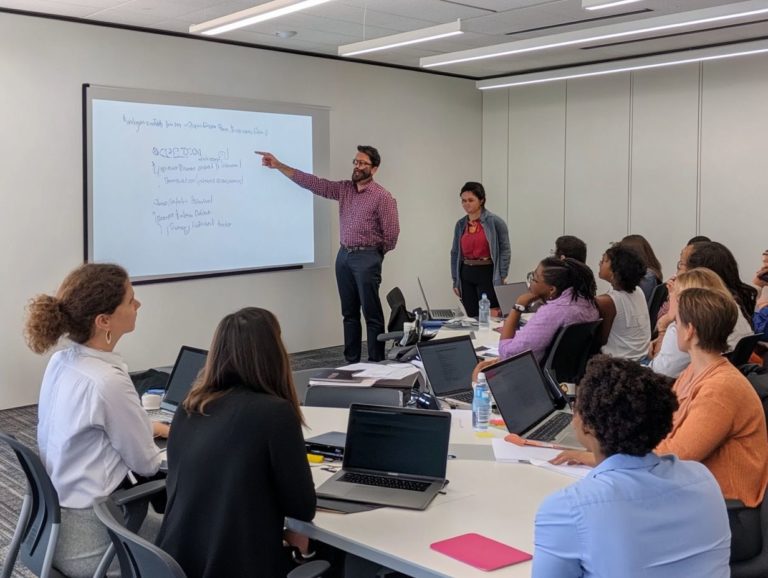How to Foster Team Collaboration in Training?
In today’s fast-paced work environment, effective team collaboration is essential for successful training initiatives. It benefits individual learning and significantly enhances overall organizational performance. However, obstacles may hinder effective teamwork.
This article delves into the importance of collaboration in training, identifies common barriers you might face, and provides actionable strategies to overcome them.
You ll discover useful tools and technologies that facilitate collaboration and learn how to measure its success through key performance indicators. Join in as we unpack the essentials of fostering teamwork in training settings.
Contents
- Key Takeaways:
- The Importance of Team Collaboration in Training
- Barriers to Team Collaboration in Training
- Strategies for Fostering Team Collaboration
- Tools and Technologies for Facilitating Collaboration
- Measuring the Success of Team Collaboration in Training
- Frequently Asked Questions
- What is team collaboration in training and why is it important?
- How can I foster team collaboration in training?
- Why is effective communication key to fostering team collaboration in training?
- What are the benefits of fostering team collaboration in training?
- How can I promote a culture of collaboration in my training sessions?
- What are some common challenges to fostering team collaboration in training and how can I overcome them?
Key Takeaways:

- Effective team collaboration in training leads to numerous benefits for individuals and organizations, including improved learning outcomes and increased productivity.
- Barriers to collaboration can be overcome by identifying and addressing obstacles such as communication issues and lack of trust within the team.
- Utilizing a combination of effective communication techniques, team-building activities, and collaboration tools can greatly enhance team collaboration and training success.
The Importance of Team Collaboration in Training
Team collaboration in training is vital for cultivating a workplace culture where you can truly thrive and develop your skills. It enhances communication, fosters trust among team members, and creates a creative environment that spurs innovation.
Prioritizing teamwork boosts performance and drives employee retention! It builds a vibrant community that aligns with your organization s mission and values.
Benefits for Individuals and Organizations
The advantages of effective teamwork in training resonate deeply with both individuals and organizations. When you collaborate seamlessly with your peers, you often find a surge in motivation. Shared goals cultivate a sense of accountability and purpose.
Improved communication among team members facilitates the exchange of ideas and fosters an environment where constructive feedback flourishes. This vibrant atmosphere is essential for sharpening problem-solving skills, enabling teams to tackle intricate challenges more efficiently.
According to Gallup, organizations with high employee engagement often a product of strong teamwork experience a remarkable 21% increase in productivity. Insights from Zippia show that companies prioritizing collaborative efforts enjoy lower turnover rates, significantly contributing to overall organizational success.
Barriers to Team Collaboration in Training
While recognizing the undeniable advantages of team collaboration in training, you may encounter various barriers that impede effectiveness. These barriers can lead to challenges in communication and trust among your employees.
Identifying and Overcoming Obstacles
Identifying and overcoming obstacles to team collaboration demands your effective leadership and clear communication to create an inclusive environment. Actively engage with your team by utilizing open-ended questions that inspire dialogue and elicit valuable feedback.
Prioritizing transparency is essential; share your goals, challenges, and progress updates to cultivate trust among team members. Consider implementing training sessions that focus on conflict resolution and effective communication techniques.
These sessions will equip individuals with the skills necessary to navigate differences and collaborate successfully. By fostering a mindset of adaptability, you enable your team to swiftly adjust to unforeseen challenges, ultimately enhancing productivity and cohesion within the group.
Strategies for Fostering Team Collaboration

You can cultivate team collaboration by employing strategies that highlight effective communication techniques, engaging team-building activities, and a rich culture of feedback and brainstorming.
Effective Communication Techniques
Effective communication techniques are essential for fostering collaboration among team members. They enhance overall engagement.
By adopting strategies like active listening really paying attention when someone is speaking you’ll notice a significant improvement in the quality of interactions.
Regular check-ins are vital. They help your team assess progress and tackle challenges, ensuring everyone stays aligned with common goals.
Emphasizing transparency in information sharing builds trust and openness. This creates an atmosphere where individuals feel valued and truly heard.
Implementing organized ways to give feedback encourages constructive dialogue. This reinforces a culture of collaboration, enabling each team member to contribute meaningfully.
Team Building Activities
Team-building activities can transform your workplace. They boost collaboration and creativity within your workplace and foster a supportive community among employees.
These activities, ranging from interactive workshops to engaging retreats, provide an opportunity for team members to connect in a relaxed environment.
Fun challenges, whether through brainstorming sessions or friendly competitions, ignite innovative thinking and strengthen interpersonal relationships.
By engaging in these varied forms of team-building, you cultivate a sense of belonging and shared purpose, which is essential for a thriving workplace culture.
Organizations that prioritize such initiatives often experience improved morale and greater overall productivity. This ultimately drives success for everyone involved.
Tools and Technologies for Facilitating Collaboration
Utilizing the right tools and technologies is essential for fostering collaboration among your team members. These tools enhance communication and elevate productivity during training sessions.
Virtual Collaboration Platforms
Virtual collaboration platforms are critical for remote teams. They enable seamless communication and spark innovation, regardless of where team members are located.
Tools like Slack, Microsoft Teams, and Zoom offer functionalities that extend far beyond simple messaging and video calls.
For example, Slack’s channel integration allows you to create focused discussions around specific projects, making organization a breeze.
Microsoft Teams enhances your efficiency with robust file-sharing capabilities. This means team members can share documents easily and work on them together.
Meanwhile, Zoom s breakout rooms facilitate smaller group discussions, enhancing collaborative efforts.
Together, these platforms not only streamline your workflows but also nurture a sense of community. They reinforce connections among team members who may be spread across various time zones.
Project Management Software

Project management software like ClickUp and Asana elevates your team’s collaboration by streamlining workflows and tracking performance metrics efficiently.
These tools cultivate seamless communication among your team members by offering shared workspaces, where ideas can truly flourish.
Features such as real-time collaboration, task assignment, and deadline tracking enhance visibility and accountability. This ensures that everyone is crystal clear on their responsibilities and timelines.
With customizable dashboards and robust reporting capabilities, you can analyze progress and swiftly address any bottlenecks that arise.
By integrating file sharing and discussion forums, this software transforms the traditional project management experience into something dynamic and engaging. This ultimately drives higher productivity and strengthens team cohesion.
Measuring the Success of Team Collaboration in Training
Measuring the success of team collaboration in training is essential for grasping its influence on both individual and organizational performance.
By implementing effective performance metrics and soliciting feedback, you can gain valuable insights into the impact of collaboration and drive continuous improvement.
Key Performance Indicators
Key Performance Indicators (KPIs) are crucial metrics for evaluating team performance and collaboration in training programs.
By tracking engagement levels, you can see how actively team members participate. Monitoring project completion rates shows if teams are meeting deadlines efficiently.
These KPIs illuminate individual contributions and enhance your understanding of teamwork’s effectiveness.
Engaged teams usually show higher productivity, leading to better project outcomes. Use these data-driven insights to refine your strategies and promote collaboration.
Feedback and Evaluation Processes
Effective feedback and evaluation processes are vital for enhancing team collaboration and closing communication gaps.
Structured methods for collecting input from all members provide insights into your collaborative dynamics. This encourages participation and creates a safe environment for sharing thoughts.
Open discussions foster constructive criticism, helping everyone identify strengths and improvements. Regular feedback sessions allow real-time adjustments to keep collaboration on track.
Frequently Asked Questions
What is team collaboration in training and why is it important?
Team collaboration in training means working together towards a common goal. It s important because it improves communication, boosts problem-solving skills, and fosters unity among members.
How can I foster team collaboration in training?
Foster team collaboration by setting clear goals, encouraging open communication, promoting trust and respect, and utilizing team-building activities.
Why is effective communication key to fostering team collaboration in training?
Effective communication allows team members to share ideas and feedback, clarify expectations, and resolve conflicts, leading to better understanding and cooperation.
What are the benefits of fostering team collaboration in training?
Benefits include increased productivity, improved problem-solving abilities, enhanced creativity, and stronger relationships among team members.
How can I promote a culture of collaboration in my training sessions?
Promote collaboration by encouraging active participation, recognizing teamwork, providing opportunities for peer learning, and leading by example.
What are some common challenges to fostering team collaboration in training and how can I overcome them?
Common challenges include conflicting personalities, lack of trust, and communication barriers. Overcome these by promoting open communication, addressing conflicts promptly, and providing training on effective teamwork.






